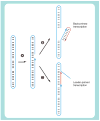Origin of hepatitis delta virus
- PMID: 20210550
- PMCID: PMC2852136
- DOI: 10.2217/fmb.10.15
Origin of hepatitis delta virus
Abstract
This article addresses some of the questions relating to how hepatitis delta virus (HDV), an agent so far unique in the animal world, might have arisen. HDV was discovered in patients infected with hepatitis B virus (HBV). It generally makes HBV infections more damaging to the liver. It is a subviral satellite agent that depends upon HBV envelope proteins for its assembly and ability to infect new cells. In other aspects of replication, HDV is both independent of and very different from HBV. In addition, the small single-stranded circular RNA genome of HDV, and its mechanism of replication, demonstrate an increasing number of similarities to the viroids - a large family of helper-independent subviral agents that cause pathogenesis in plants.
Figures


References
Bibliography
-
- Rizzetto M, Canese MG, Gerin JL, London WT, Sly DL, Purcell RH. Transmission of the hepatitis B virus-associated δ antigen to chimpanzees. J Infect Dis. 1980;141:590–602. - PubMed
-
- Taylor JM, Farci P, Purcell RH. Hepatitis D (δ) virus. In: Knipe DM, editor. Fields Virology. Lippincott Williams & Wilkins; PA, USA: 2007. pp. 3031–3046.
-
-
Deny P. Hepatitis δ virus genetic variability: from genotypes I, II, III to eight major clades. In: Casey JL, editor. Hepatitis δ Virus. Springer; Heidelberg, Germany: 2006. pp. 151–171. ▪▪ Defines the many clades of hepatitis δ virus HDV.
-
Website
-
- Subviral RNA Database. http://subviral.med.uottawa.ca.
Publication types
MeSH terms
Grants and funding
LinkOut - more resources
Full Text Sources
Other Literature Sources
Medical
